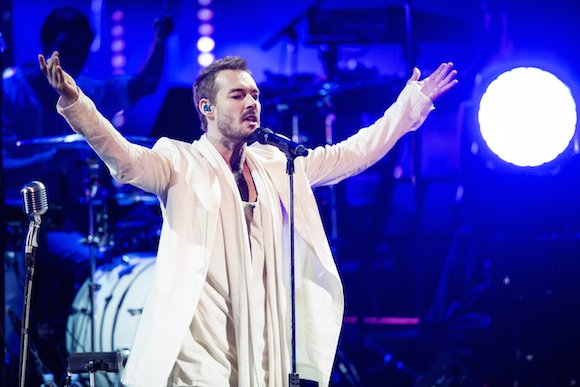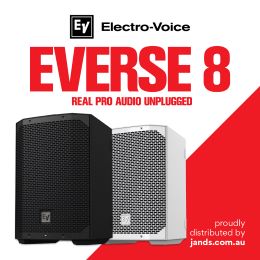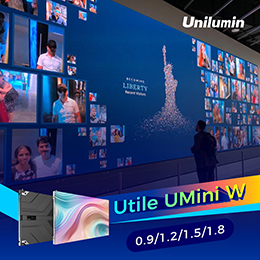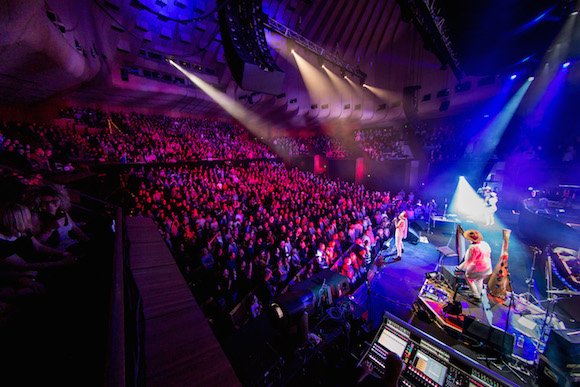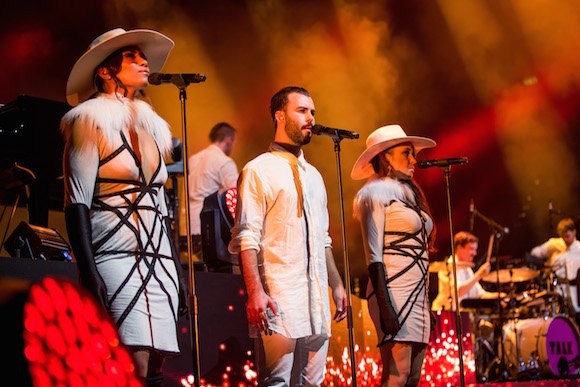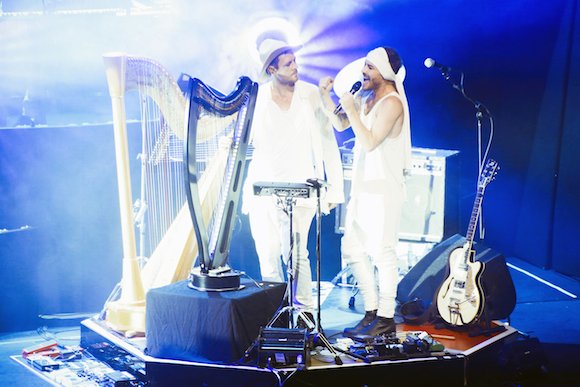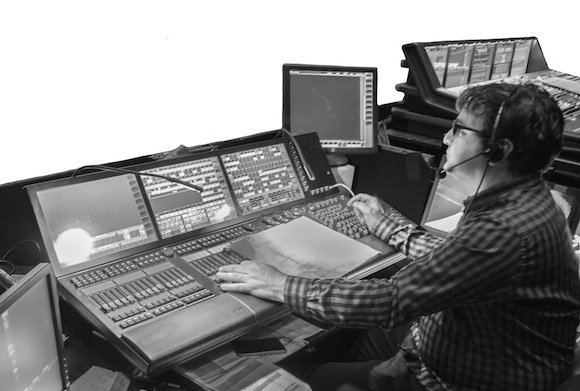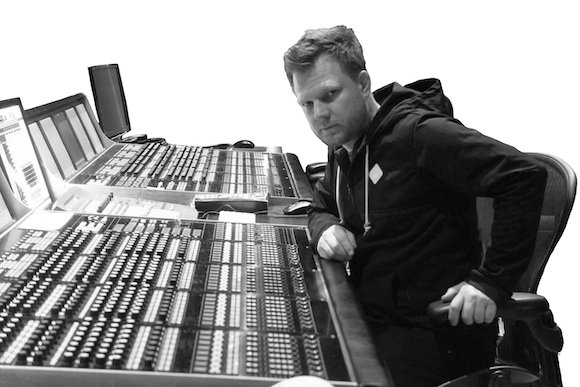Subscribe to CX E-News
A highlight of 2015’s Vivid LIVE series of concerts, was the performance of former silverchair lead singer and guitarist Daniel Johns at the Sydney Opera House’s Concert Hall. After five years away from the stage, Daniel Johns launched his recent feature album Talk at the first of two sold-out shows.
Lighting designer Hugh Taranto used the Vivid rig that was installed into Concert Hall for all of the Vivid Live shows, however he was able to bring in a fairly comprehensive floor lighting package as well as screens. The Vivid rig, designed by Mark Hammer, comprised of Martin MAC Viper Performances, MACIII’s, MAC700 Spots, MAC101’s and Clay Paky Sharpy Washes
Prior to the gig, Hugh spent time with the band in their rehearsal studio and armed with a MA console with MA 3D set up and the Catalyst media server, he was able to create a previsualization. At the same time animator Glenn Wilson was creating the visual content so, along with the band too, the creative team worked closely together in preparation.
“This programming time was essential,” says Hugh. “There was little time to set up due to the busy Vivid schedule and we bumped in on the morning of our first show. Daniel wanted a rich show in terms of visual content to the extent whereby Daniel and his seven- piece backing band all wore white outfits so that they could be projection surfaces.”
The show was an evolution from start to finish rather than a collection of individual song looks. It began with projection on a downstage black scrim that masked the band. Within the content projected onto the scrim was a small window that opened up to reveal Daniel singing Aerial Love. The scrim stayed down for most of the second song, dropping from a kabuki as the songs built to a finale.
Following this, the curved LED screens positioned around the band’s risers were revealed for three songs before a wall of thirty-six pixel-mapped ShowPro LED Hex16 Strips came to life.
“A while later, the five rear projection screens behind the band came into play,” described Hugh. “As the show was a one-off, we were able to design it to the room. That meant we could put the screens up in the choir stalls and the two outer most screens were very much built into the side seating areas. It wouldn’t be a show you could just roll into a theatre and set up.”
Towards the end of the set, the show really peaked with the Concert Hall’s inbuilt LED houselights incorporated into the lighting. These were pixel-mapped so content ran through the Hex Strips, screens and then also the house lights through the room. The 355 custom-made LED lights were installed recently to fit with the building’s heritage fixtures, and provide spectacular displays both on and off the stage.
“It was a very immersive and probably unexpected experience for the audience,” said Hugh. “Catalyst ran custom projections through the five rear projection screens, the curved LED in front of band and also the pixel mapped content through the Hex Strips and LED house lights. The two Catalysts were sometimes running timecode but mostly running through the MA console.”
Crucial to the design were twelve Clay Paky B-EYEs dotted around the stage floor. Late in the show all video was turned off and the B-EYEs were used as beam effects filling the whole stage, a dynamic look after quite a lot of video usage.
“They really carried the song which is hard when you’ve had high impact visual content running for the rest of the set,” said Hugh. “To step back and just have the B-EYEs in use was really good.
“I really like the Hex Strips too. Each strip has 16 cells of six colours – red, green, blue, white, amber and UV and therefore each strip is 96 channels. We had thirty- six running over five DMX universes and were able to pixel-map them with the RGB enabling us to run video content through them. When we were running video content through the floor LED screens and also the roof, the Hex Strips formed a connection between them. The Hex Strips were pixel-mapped via Catalyst but merged through the lighting console so we were able to use them to accent beats and run effects from the console if we wanted. Having the white cell in them was pretty extreme and bright! It’s the first time that I’ve used them and they were really quite a dynamic effect, I was very happy with them.”
Also in the rig were a couple of Martin 365 Hazers and twelve ETC Pearl LED uplights. The show was run through a full size MA console with a NPU.
Chameleon Touring Systems provided the additional lighting whilst the screens and projection equipment came from Technical Direction Company. The Opera House Technical teams managed the setup and smooth operation of the gear.
This was FOH mix engineer Lachlan Carrick’s first time working for Daniel Johns. He is the current FOH engineer for Gotye, joining in for the last two world tours, while other live mixing credits include The Cat Empire, Lior, The Necks and Katie Noonan.
Lachlan used the SOH’s in-house d&b audiotechnik J-series stereo line array and fill system adding some d&b infra subs from JPJ Audio.
“The system felt great to mix on, and the extended sub- bass was just the ticket for Daniel’s music,” commented Lachlan. “Big, reverberant halls always make me feel a bit stressed in the lead-up to a show like this. But in the end, with full houses, it sounded great. I would have preferred the reverb to be a few dB quieter, but it is what it is.”
Lachlan used an Avid Profile favouring its’ plug-ins live, and according to him, no other console integrates them better.
“Automation is a breeze and I’ve used it so much, it feels more like an instrument to me,” he added. “For this gig I kept it all in the box with lots of Waves plugins such as the C6 Multiband Compressor, Renaissance Vox, SSL Stereo Bus Compressor, L3-LL Multimaximizer limiter, Renaissance Reverb, and H-Delay. Plus I use the SPL Transient Designer quite a bit on drums.
“There are no special requirements for Daniel’s voice, I just wanted to make it big, juicy and engaging. He really is a fantastic singer, and making sure the audience gets to appreciate that is a huge priority.”
Lachlan admits that mixing for the two Vivid Live shows was a bit of a rollercoaster as they were essentially a one- off event, adding a touch of adrenaline to the nights. He commented that Daniel can be an unpredictable force – albeit in a great way – so he always had to ride the vocal.
Lachlan brought along a bunch of Earthworks mics for drums, which he started using with Gotye. There were DP30/C goosenecks for snare top and toms, with SR40’s for overheads and hats. For Daniel’s vocal, Lachlan chose the DPA d:facto II, and it proved to be a great mic for the job.
“I found it to be very honest and super-clear, while taking EQ very well,” remarked Lachlan. “Also, I had no feedback problems, despite high gain and the fact that Daniel loves nothing more than lying down next to the front fill to sing to the front row.”
Rod Matheson mixed monitors on a DiGiCo SD7 console and Lachlan describes his work as just awesome.
“He’s at the very top of the game, and it really makes a difference to how the show works,” said Lachlan. “All the musicians are loving the sound in their ears, playing great, and out front you can feel that.
“It was a very ambitious gig with high stakes, but the entire production team was up to the task, and along with Daniel and the band, managed to deliver two super high-grade shows.”
(Photo Credits – Daniel Boud and Prudence Upton)
Subscribe
Published monthly since 1991, our famous AV industry magazine is free for download or pay for print. Subscribers also receive CX News, our free weekly email with the latest industry news and jobs.


